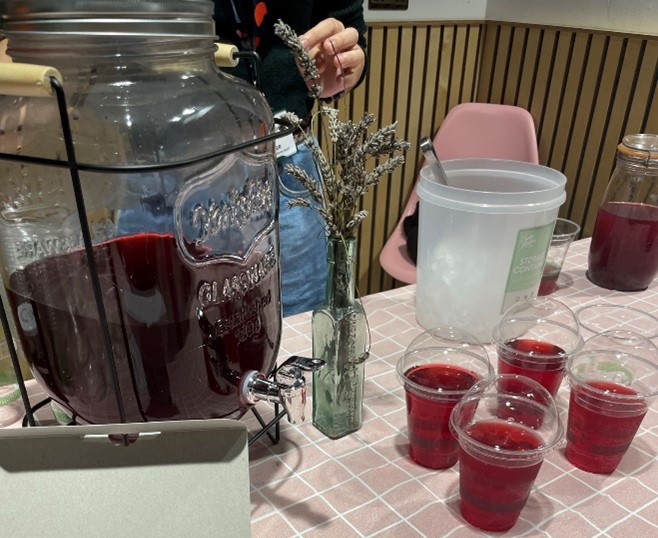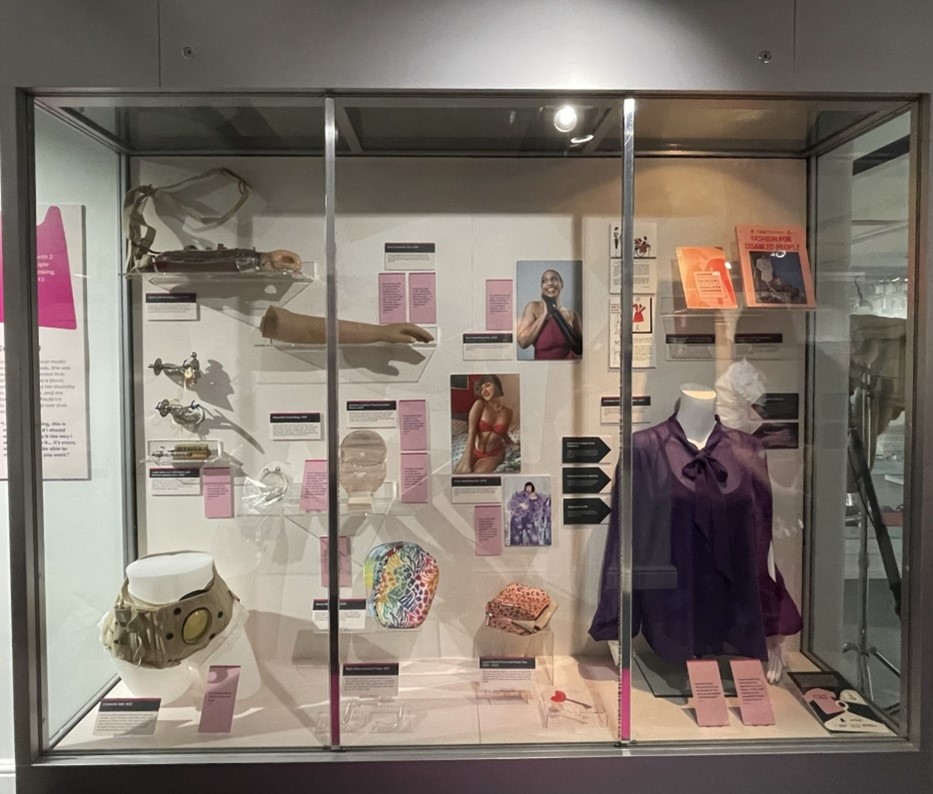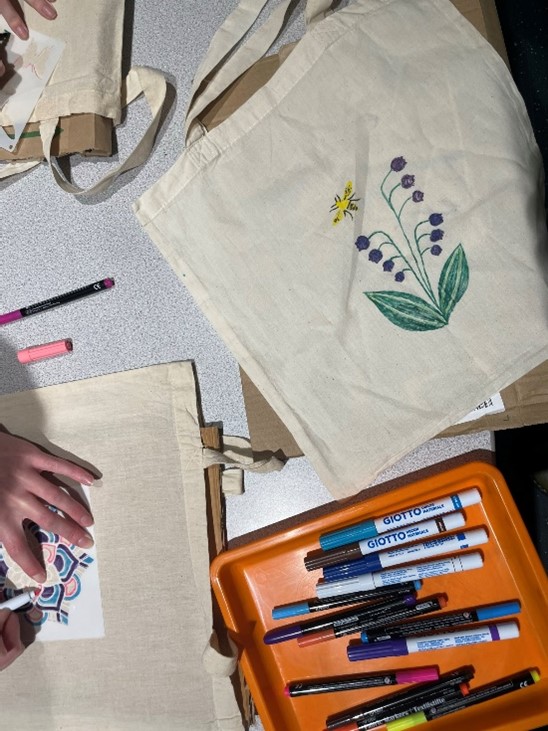PDRA for Strand A, Sophie Vohra, reflects on her visit to the Thackray Museum of Medicine in Leeds to attend the opening of Curating for Change Fellow, Amelia Silver’s exhibition, ‘Dressing Disability’. Sophie has written image descriptions for each photo featured and these are included in the text.
Into the Museum
This Grade II listed space was formerly the Leeds Union Workhouse (1861) later becoming primarily a space for medical care for the poor, the East Leeds War Hospital (1914-1918) and finally becoming part of St James’s Hospital (named in 1925) until 1990. This history is certainly reflected in its architecture.
The entrance to the building is something to behold. As you enter the venue, you can hear the sounds of chatter and footsteps on the polished, wooden Herringbone Parquet floor echoing around the beautiful art nouveau space, with cream walls, deep beetle green tiling with an amber, brown and teal trim lining a meter up along the base of the walls on the maroon-floored, double-sided grand staircase that goes all the way to the top floor of the building.
If you gaze up to the top of the interior, you also see an impressive Victorian plaster moulded ceiling with a beautiful bright red background and cream, curving geometric decorative design that is fun to trace around with your finger to experience the flow and shape.
Such an entrance way was certainly a foreshadowing for the incredible opening event and the amazing exhibition in which Amelia, in co-creation with fashion influencer, Lucy Jane, who uses a stoma, and professional model and poet, Enas Saeed, who has a bionic arm, wonderfully married the concepts of fashion and medicine.
A warm (and sensory) welcome
We were welcomed with opening drinks and nibbles on the ground floor, and had the opportunity to connect with lots of people from Thackray Museum of Medicine, Curating for Change, the co-creators, and others with an interest in Amelia’s work. This was accompanied by two of the most incredible examples of mixology to compliment the exhibition and the two co-producers:
Enas’ ‘Bionic Bae’ Spritz: Hibiscus and lavender tea; blueberry and lavender shrub; soda water.
Lucy’s ‘Stylish with a Stoma’ Spritz: Elderflower, rose and butterfly pea tea; plum and rosewater scrub; and tonic water.
Everything about these made for the most amazing sensory experience as you tasted the smell of all the ingredients in these deep purple and red drinks, and such a fantastic start to the event.
After a wonderful speech by Amelia about the making of this exhibition, we went up to the 1st floor (by lift and by staircase) and were at once welcomed into the gallery space by the beautiful exhibition.

Image description: A pink squares and white outlines table cloth. On the table are four Vegware cups filled with dark red liquid, a glass jar with two thirds full red liquid, a translucent tub of ice and a large glass drinks dispenser with a silver tap and on a black wire stand with pale wooden handles with a third of it filled with dark red liquid. In the middle of the image is the central part of a person with their hand pinching a piece of lavender that is in a bunch in a clear glass bottle.
Enjoying the exhibition
In the spirit of what Thackery Medical Museum strives for, Amelia highlighted the human and the beautiful connected to the medical care and apparatus. The narrative of the exhibition was well crafted with a clear message: personal medical equipment should be, and is increasingly being, seen as something that is as a part of, an extension of, the self, and that the stylisation of those items could and should be able to fit with that of the other the wearer/user’s fashion.
The case of objects beautifully illustrated not only the evolution of medical devices, but also the progression of how fashion has developed, including beautiful stoma covers, and a shirt with various features to make personal medical care easier while still being incredibly fashionable.

Image description: Silver metal and glass object case in a museum with examples of personal medical equipment. accessories and garments, and literature. These are accompanied by black and pale pink written description labels, and fashion photographs of the two co-curators.
There is a wonderful audio description that can be accessed by a QR code printed on the wall. This had full readings of the panels and object labels, with Enas and Lucy reading their own quotes, as well as orientating you around the space so you knew which panel you were engaging with. This can be found at: www.soundcloud.com/thackray-museum-of-medicine/sets/dressing-disability.
Though I am glutton for more information, the length of the exhibition was really appreciated. Too often there is a lot of information to absorb and digest, which can make it difficult to keep concentration and therefore fully understand the content and purpose of an exhibit. Amelia found the perfect balance of presenting so much new and informative content, with Enas and Lucy at its core, without overwhelming the visitor with everything and the kitchen sink to narrate her exhibition.
A chance to reflect
The session was complimented by a session to design/decorate your own tote bag. Aside from being a wonderful idea, it was a warm and welcoming space to talk with others at the event, and to hear people talking about their experiences and understandings of what Amelia had curated.

Image description: In the top right corner, a cream tote bag with a yellow and black bee, and green and purple bluebell drawn using marker pens and a stencil in the centre of the bag. Along the left side are two sets of hands using stencils to draw multi-coloured designs on cream tote bags, with a black and pink marker pen, and a pale pink pen lid lay in the space between them. In the bottom right is a bright orange tray with a variety of types and colours of marker pens. There is pale grey speckled table in the background.
Some The Sensational Museum suggestions
The Sensational Museum have a few suggestions that we hope can help make outstanding exhibitions like Amelia’s even more impactful.
Descriptions
Though the object labels gave a great description of the usability, social context, and co-creator reflections, it would have been amazing to have even more consistent sensory information (visual, sound, feel, smell, interoception, movement etc.) to give rounded descriptions to allow visitors to understand the objects in a variety of ways.
The space
The position of the exhibition was in a narrow walkway that led into the rest of the gallery space, which requires you to be mindful of others entering the space. If you do visit, please take care of yourself and others in this area.
Some of the visitors that evening (including myself) were not aware that the area was the only space for Amelia’s exhibition, and the rest of the gallery was for other content. This could have been helped, for example, by having different flooring, like the exhibit area being a distinctly contrasting colour or texture/material to that of the corridor and the rest of the gallery.
Audio description
It would have been great to have headsets/devices to just pick up and borrow if you could not use it on a mobile device with internet access.
Additionally, while the audio description is well-crafted, you can still hear sight at the core of the visitor journey (e.g., look at the panel on the left; look into the mirror… what does a disabled person look like?). I wonder what that would look like if you took movement by sight out of it?
Finally, it would have been great to have a transcript with the audio description, which could provide access to the exhibition content in more ways outside of experiencing it in the museum.
As ever, we hope our thoughts and reflections on changing and developing museum theory and practice can get us ever closer to an anti-ableist way of experiencing what this sector has to offer.
A big thank you
We cannot thank Curating for Change, the Thackray Museum of Medicine, and Amelia Silver enough for inviting The Sensational Museum to this opening event. Amelia delivered an incredible exhibition, and we cannot wait to see what else she achieves as her career progresses.
Visiting Thackray Museum of Medicine
Dressing Disability runs until 26th October 2024.
Full information on the museum: https://thackraymuseum.co.uk/
Map of the site including sensory information: https://thackraymuseum.co.uk/wp-content/uploads/2021/12/TMM-floorplans.pdf
Current accessibility guide PDF: https://thackraymuseum.co.uk/wp-content/uploads/2020/11/Thackray-Museum-of-Medicine-Accessibilty-Guide.pdf
